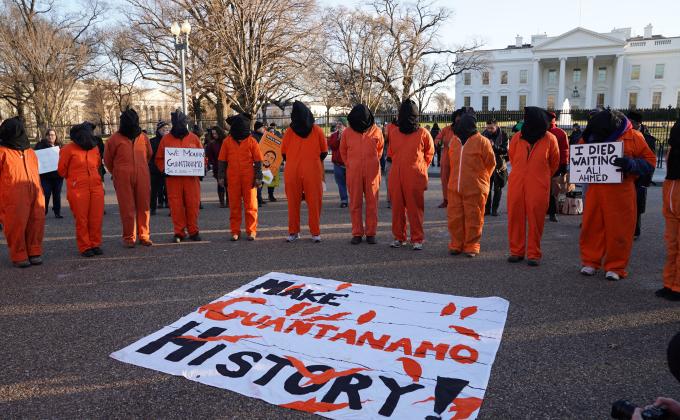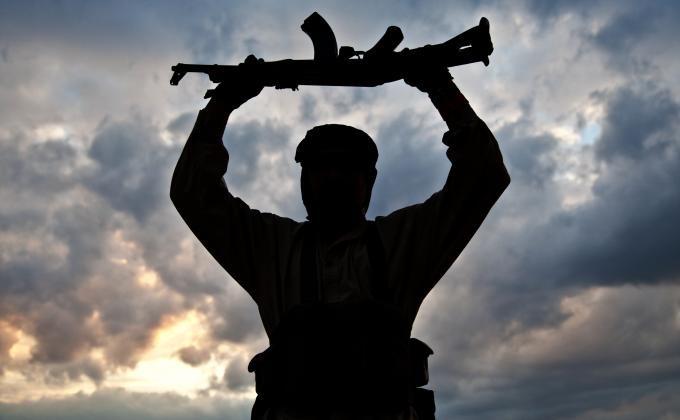Introduction
In the past months, there has been considerable discussion about whether or not foreign fighters and their families currently detained in camps in Syria should be repatriated. An often-heard justification in Western Europe not to opt for repatriation is the fact that prosecution of the adults will often lead to light sentences and thus an early release. This is indeed often the case as (returning) foreign fighters are usually merely prosecuted for being members of a terrorist organisation. As a result, the laws of war (also referred to as International humanitarian law) only play a modest role. This approach is understandable from a practical point of view, as it is much easier to prove this general offence than the actual crimes that have been committed on the battlefield. However, there are also disadvantages to this approach, as we will see later in this Perspective.
In this ICCT Perspective, an explanation of international humanitarian law will be given, followed by how it applies to the conflicts in Syria and Iraq and thus to the foreign fighters active within these conflicts. After that, a number of misconceptions about international humanitarian law and armed groups more generally will be presented. Subsequently, the interaction between counter-terrorism and international humanitarian law will be discussed, as well as the opportunities that the latter field of law can provide in the prosecution of foreign fighters. We will end with some concluding remarks and concrete recommendations.
International humanitarian law: a recap
International humanitarian law or IHL was drafted to regulate warfare and has a dual purpose: on the one hand, it contains rules that are designed to protect people from the fighting. On the other hand, it contains rules that regulate how the armed conflict is fought, for instance what weapons can be used and who can be targeted.
IHL applies both to international armed conflicts (IACs) – between States – and also to non-international armed conflicts (NIACs) or civil wars, namely armed conflicts that are fought between a State and an armed group or between armed groups amongst themselves. In this Perspective, we focus on foreign fighters who are fighting in Syria and Iraq on the side of rebel groups such as Islamic State (IS). This means that for both Syria and Iraq, we have to look at IHL applicable to NIACs.
The IHL that applies to NIACs is found in three main sources of law. The first is Common Article 3 (CA3). This provision is the identical third article common to the four 1949 Geneva Conventions (GCs) that were drafted after the Second World War. CA3 will be explained in more detail below. The second source, which sometimes applies to NIACs, is Additional Protocol II (APII). This is a treaty that was drafted by States in 1977, and emerged out of a feeling that CA3 was not sufficient to regulate NIACs. However, because many States felt uncomfortable about the imposition of more rules on situations involving high security threats, they drafted a treaty that would only apply in armed conflicts that were a bit more entrenched than CA3 conflicts. Hence, they referred to the need for an armed group to control territory and the need for an armed group to be able to conduct sustained and concerted military operations. This threshold of application is slightly higher than that of CA3. Ultimately, even the inclusion of this wording regarding a higher threshold was not enough comfort for some States that did not sign APII. Therefore, it is always important before referring to this document to examine whether the State on whose territory the armed conflict is taking place has signed. Syria and Iraq for example have not ratified APII, which is why this treaty does not apply to these conflicts. It is not necessary to ask the same question with regard to CA3 because all four GCs have been universally ratified. The third and final source of IHL that applies is customary international law, which consists of State practice and opinio juris, the belief that this practice was carried out because of a legal obligation. The International Committee of the Red Cross (ICRC) has produced an authoritative study of the content of customary IHL, which can be found online.
Coming back to CA3, this article is generally thought to be the most important provision when it comes to the prosecution of armed group members. Despite the fact it is only one article, it is far-reaching in its content. It is for that reason that it has sometimes been called a ‘convention in miniature’. It identifies a group of people to whom it confers protection. These are persons taking no part in the hostilities. They may be civilians but also members of armed forces (a term taken to mean either State armed forces or members of armed groups fighting) who have laid down their arms, i.e. surrendered, and those who have been placed hors de combat – those who cannot fight anymore, due to being sick, wounded, or detained. It protects these persons in two main ways. First it contains a positive obligation on the fighting parties – i.e. the State and the armed groups – to treat these persons humanely. Secondly, it prohibits the fighting parties carrying out a number of acts i.e. murder, outrages upon personal dignity, and extrajudicial executions. It also contains an obligation that the sick and wounded should be cared for.
In examining whether someone can be prosecuted for war crimes that have been committed in the context of a NIAC, the first question to ask is whether IHL applies. In view of the fact that APII does not apply to Syria and Iraq, let us have a look at the threshold of CA3 more closely.
Case law from international criminal tribunals has been instrumental in defining this threshold, as the ad hoc International Criminal Tribunals for the former Yugoslavia (ICTY) and for Rwanda (ICTR), as well as the permanent International Criminal Court (ICC) have always had to determine whether IHL applies as a jurisdictional matter, before any war crimes can be prosecuted. This case law has made clear that two elements are important: (i) the intensity of the violence and (ii) the organisation of the armed group.
Looking at the intensity of the violence first, it is clear that for IHL to apply there needs to be violence of quite some degree of severity, on both sides. The tribunals have taken note in this regard of whether there is a pattern of violence (as opposed to a one off incident), to whether the government has mobilised the army (as opposed to the police force), what kinds of weapons are used by both sides, with particular attention given to ‘heavy weapons’, whether the hostilities are having an effect on the civilian population, and, very importantly, whether the international community is involved, for instance through resolutions by the Security Council or the participation of international mediators.
Turning to the organisation requirement, what is important here is whether the opposition fighting the government are a loose collection of individuals or whether they can be seen to be a collective entity under international law capable of bearing obligations under IHL. The ICTY Trial Chamber’s judgment in the Boškoski case is probably the most helpful in this regard, setting out five indicators that may be relevant to an assessment of this. These indicators take note of the following: (i) the group’s command structure; (ii) the group’s ability to carry out operations in an organised manner; (iii) its logistics; (iv) its discipline and ability to implement IHL provisions and (iv) its ability to ‘speak with one voice’, i.e. does it have a spokesperson and are orders issued by the leader obeyed in the lower ranks? If a cease fire is called, is it abided by?
Looking at these criteria and applying them to situations around the world, it will not come as a surprise to see that we have and have had many NIACs around the world to which IHL applies. Not just Syria and Iraq, but also Afghanistan, Yemen, Colombia, Sudan, DRC, Uganda, the Philippines, Nigeria, and many more.
The armed groups involved in these conflicts are very different in outlook, philosophy, structure and aim. Their names reflect this, with some reflecting an Islamic agenda, others a liberation agenda, others a ‘democratic’ agenda, and others a revolutionary agenda. This brings us to the next part of this Perspective, which is intended to address eight misconceptions or ‘myths’ regarding armed groups and IHL.
Misconceptions about armed groups and international humanitarian law
- IHL only applies to armed groups that want to form an independent State.
Incorrect. The motivation of the armed group is not relevant to the application of IHL.
- IHL only applies to armed groups that are State-like.
Incorrect. The case law on the application of CA3 – and even the drafting papers to CA3 – clarify that armed groups can be bound by IHL even if they control little territory and only have quite a rudimentary organisation.
- IHL only applies to armed groups that are terrorists.
Incorrect. Case law indicates that the label ‘terrorist’ has nothing to do with a determination of whether an armed group is bound by IHL.
- IHL never applies to armed groups that are called terrorists.
Incorrect. The labelling of an armed group as a terrorist group is not relevant to the determination of whether IHL applies to a specific situation.
- IHL confers combatant immunity, meaning that no State can prosecute members of an armed group if it applies.
Incorrect. Combatant immunity is a concept reserved for IACs (between States). The fact that armed groups and their members are bound by IHL does not mean that they cannot be prosecuted for domestic crimes (as will also be explained in greater detail below).
- IHL only applies if the State says/agrees that it applies.
Incorrect. States may have strategic reasons to say that IHL doesn’t apply – or does apply – depending on the politics of the situation. Case law on the threshold of IHL makes clear that a State’s view in this regard is not determinative.
- IHL only applies if the armed group in question has signed a commitment agreeing to the rule in question.
Incorrect. Such a perception may stem from the fact that there is a growing practice of armed groups signing up to deeds of commitment with regards to certain humanitarian rules. But whether or not an armed group has signed such a deed of commitment is not relevant for whether it is bound by the three sources of IHL mentioned earlier in this Perspective.
- IHL does not apply to armed groups that reject it.
Incorrect. No matter whether an armed group agrees with IHL or not, it is still bound to it as a matter of law.
Having provided a short recap of IHL and a number of misconceptions about this often forgotten field of law, we can also conclude that IHL is not only applicable to the armed conflicts in Syria and Iraq but also that the groups that were joined by foreign fighters, such as IS and al-Nusra, are bound by IHL, and thus that their members can be prosecuted for war crimes. This is clear from an examination of the organisational structure of both groups, combined with the intensity of the violence between them and their adversaries. Let us now zoom in more on the interaction between counter-terrorism and IHL, as well as the opportunities that the latter field of law can provide in the prosecution of foreign fighters.
Prosecution and opportunities provided by international humanitarian law
In the introduction of this Perspective, we indicated that foreign fighters are usually merely prosecuted for being members of a terrorist organisation. Although, as explained, this approach is understandable from a practical point of view, it has several drawbacks.
The first is that it leads to a non-tailored and ‘all size fits all’ solution. All persons who have joined IS will receive more or less the same sentence (in Western Europe usually around five to six years), no matter whether they were forced to join IS and served the Caliphate not by fighting but by preparing meals (in which case this standard sentence may be on the high side) or whether they were leading the group and responsible for international crimes such as war crimes, crimes against humanity and genocide (in which case this standard sentence would be very low). Of course, nobody wants a mass murderer to walk the streets again after a few years in prison. It can be argued that if prosecutors were able to ensure that the latter category of people are put behind bars for a much longer time, politicians would also have fewer problems than they are having now in actually taking responsibility for their own citizens – by repatriating them and letting them be prosecuted at the national level.
The second drawback is that prosecuting for membership is not very satisfactory for the victims of the crimes, as the actual crimes committed against their loved ones are not investigated or even named in the legal proceedings.
The third drawback is that the extensive use of counter-terrorism legislation has arguably overshadowed IHL, which, as was explained above, is clearly applicable as well and directly relevant to conduct associated with armed conflict.
This focus on counter-terrorism, in turn, generates a number of risks, one of them being that the lines between IHL and counter-terrorism law are being blurred because foreign fighters might be prosecuted for terrorist offenses even if they only engaged in acts that are lawful under IHL, as will be explained in greater detail below. Even more importantly, it might lead to a situation in which there is a perception that all foreign fighters are terrorists, which is incorrect.
The over-focus on CT may not only lead to a potential blurring, it may also constitute a missed opportunity, for a good understanding and application of IHL can also lead to higher sentences, and as just explained, this may convince politicians, who are currently afraid of repatriating foreign fighters as that would lead to a light sentence and an early release, to change their policies.
For example, whereas in the past a picture showing a fighter posing with a dead body would be used to prove that that person had joined a terrorist organisation, one can use that same picture to prove that someone treated a person who is protected under IHL in a gravely humiliating and degrading manner, which is a war crime under CA3. The Dutch case of Oussama A., who received almost eight years rather than the usual five-six years, is a good example in that respect. The longer sentence he received was because he was prosecuted for both terrorism crimes and war crimes. But there are more examples, such as the German Aria L. and Abdelkarim El. B. cases.
In this context, the so-called ‘IHL exclusion clause’ and its effect on possible (non-)prosecution is often discussed. For example, Recital 37 of EU Directive 2017/541 on combating terrorism adopted on 15 March 2017 specifies that “[t]his Directive does not govern the activities of armed forces during periods of armed conflict, which are governed by international humanitarian law within the meaning of those terms under that law, and, inasmuch as they are governed by other rules of international law, activities of the military forces of a State in the exercise of their official duties”. Quite some attention has been paid in case law to demonstrate that this clause is not applicable, either in general, or to cases relating to foreign fighters. In Dutch case law, it has been argued that the clause is not legally binding because it is only mentioned in recitals and that, moreover, it would in any case only apply to State armed groups and not rebel groups, to which, as a result, counter-terrorism law could be applied. In Belgium, the clause has been explicitly incorporated in the national criminal code, with judges concluding that it is not applicable in certain situations, such as the Sharia4Belgium case, but applicable in others, such as the PKK case.
In our opinion, the clause is potentially applicable to rebel groups – the explicit mention of “military forces of a State” would argue in favour of viewing the earlier-mentioned term “armed forces” more broadly – but the applicability of the clause would not necessarily mean that counter-terrorism law can never be applied either. The groups we are talking about here, such as IS and al-Nusra, are groups with a dual nature in that they fall under the national counter-terrorism legislation and are bound by IHL, as parties to NIACs. What is needed is to find the most appropriate legal framework for the groups’ acts under consideration. That means that for acts that can be linked to the actual hostilities in Syria and Iraq, IHL should apply, and that for activities in Syria and Iraq that are in principle not connected to the fighting on the battlefield as such – such as making propaganda videos with the purpose of recruiting individuals in Western Europe – counter-terrorism law should apply. For the first category of activities, IHL does not prohibit lawful acts of war, such as attacks against military objectives or against individuals not entitled to protection against direct attacks. However, it does prohibit a certain number of specific acts, such as executions of civilians and persons hors de combat, hostage taking and deliberate attacks against civilians and civilian objects, which, outside of the context of armed conflict, would be qualified as terrorist acts. In addition, next to these more general prohibitions presenting similarities with terrorism, there is a more specific rule under IHL prohibiting acts or threats of violence the primary purpose of which is to spread terror among the civilian population.
It should be stressed that the fact that IHL does not prohibit lawful acts of war, such as attacking a military objective, does not mean that such acts may not be prohibited under national law when committed by a member of a non-state armed group. Notably, members of rebel groups do not have combatant privilege, in contrast to soldiers in IACs. However, the question is whether someone should be prosecuted under national law (of the territorial State or of the foreign fighter’s home State) for acts that are not prohibited under international law. We argue that this should ideally not be the case, and that, even if members may be punishable under national law, consideration should be given to creating an amnesty for lawful acts of war so that they are not prosecuted, in line with Article 6, paragraph 5 Additional Protocol II. There is an important compliance consideration here as well; if members of armed groups know that they will be prosecuted for lawful acts of war, then what is the incentive for these individuals to follow IHL in the first place? Such reasoning may not be very convincing in the context of a group like IS, which is unwilling to apply IHL in any case, but we should never forget that IHL goes far beyond the specific context of IS only. To ensure a broad application of IHL around the globe, this is arguably the best approach, whether IS is willing to follow IHL or not. If it is decided that amnesty is not an option and that members of armed groups should be prosecuted under national law for mere participation in hostilities nonetheless, then it is argued that they are to be prosecuted for neutrally formulated crimes, such as murder and manslaughter or destruction of property, rather than terrorism-related acts. This will further avoid the blurring of these two legal fields.
Conclusion and recommendations
In this Perspective, IHL, an often forgotten field of law in the context of countering terrorism and the phenomenon of foreign fighters, was put in the spotlight.
Three reasons are regularly invoked explaining why IHL is not commonly relied upon in domestic courts: (1) the judicial efficiency argument; i.e. membership of a terrorist organisation is much easier to prove; (2) IHL is little known by domestic judges, and (3) the misconception that invoking IHL would lead to impunity.
In this Perspective, we have stressed the importance of prosecuting for actual acts rather than merely for membership of a terrorist organisation. As already admitted, we understand that the call to focus on the actual acts is of course also very much dependent on the availability of the evidence and that this is a huge challenge. However, more and more evidence comes to the surface, sometimes literally through the discovery of mass graves, now that the so-called Caliphate of IS has collapsed. Moreover, a stronger role of the military in securing evidence can be considered. Besides such military or battlefield evidence, other forms of evidence that could be used more frequently are forensic evidence, electronic evidence and intelligence information, and the Global Counterterrorism Forum’s Abuja Recommendations on the Collection, Use and Sharing of Evidence for Purposes of Criminal Prosecution of Terrorist Suspects have collected some useful good practices in that field. Moreover, it is sometimes also a matter of how existing evidence is used (cf. the picture to prove membership or to use that same picture to prove war crimes).
As to the lack of knowledge about IHL: this is indeed a serious issue, and also one of the reasons why we have written this Perspective. More structurally, it would be good a) if countries can establish specialised war crimes units and b) encourage the cooperation and coordination, or even the integration, of such a unit with/in any pre-existing counter-terrorism apparatus.
Finally, that invoking IHL would lead to impunity is one of the many misconceptions about this rather technical and specific field of law which this Perspective has tried to demystify. It has been clearly established that IHL does not lead to impunity for war crimes. To the contrary: it might actually help increase the sentence of fighters who not only committed crimes under counter-terrorism law but also violated IHL.
*This Perspective is based on two presentations provided by the authors at the 27th Meeting of the Network for investigation and prosecution of genocide, crimes against humanity and war crimes (EU Genocide Network), held at Eurojust in The Hague on 6 November. The presentation by Hanne Cuyckens and Christophe Paulussen, in turn, is based on their article ‘The Prosecution of Foreign Fighters in Western Europe: The Difficult Relationship between Counter-Terrorism and International Humanitarian Law’, available at: https://ssrn.com/abstract=3471908.










